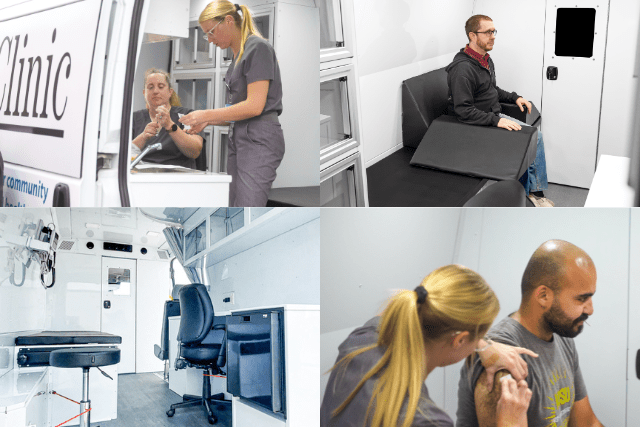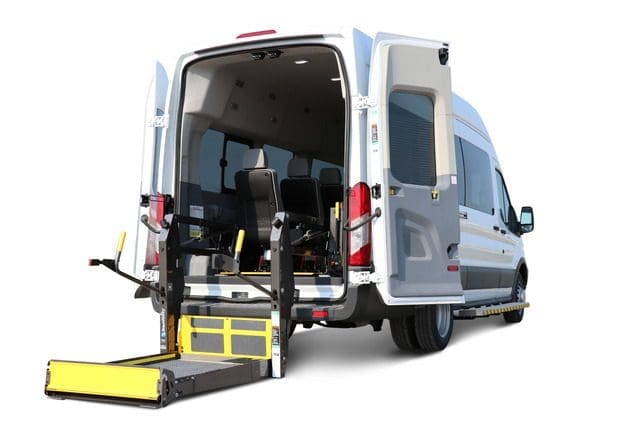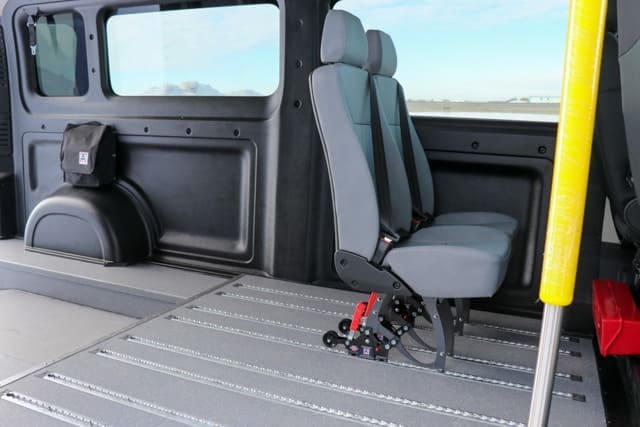You know you need an accessible vehicle to transport your clients–whether it’s from a care home to doctor’s appointments, providing accessible public transportation through Handi-Transit, or enjoying community outings with your clients. You also know you need to transport more clients than the average wheelchair van user. But does that mean you have to get a bus instead of a van?
Buses require a specialized license –a Class 4 license in most provinces, but it can vary depending on where you live–and can be difficult to drive due to their size–especially in rural or remote communities, where roads tend to be narrower.
So, what is the alternative? Well, that’s the question that landed you here.
Au MoveMobility, we don’t sell any buses (only full size wheelchair vans and minivans), but we’ve helped hundreds of organizations like yours choose the right accessible vehicle for them.
Even if it’s a bus that doesn’t come from us.
In this article, you’ll compare an accessible bus vs. van in terms of 7 key categories. Ultimately, you’ll learn, based on your capacity needs, current driver’s license, driving ability, and budget, which option is right for you.
Wheelchair van vs. bus: what’s the difference?
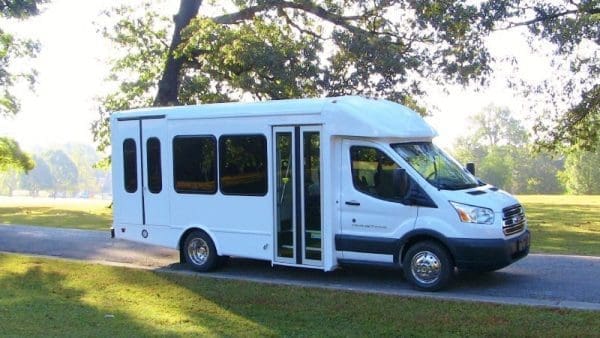

Fourgonnette
A full size wheelchair van is a vehicle that has been converted to be wheelchair accessible, with either a ramp or a lift. It’s used to provide safe transportation for individuals with all levels of mobility. Specifically, full size vans are around 25 feet long, 8 feet wide, and 7 feet tall. Check out this article for a full breakdown of everything you need to know about full size wheelchair vans.
Bus
A wheelchair bus is a bus body mounted onto a light—or heavy-duty chassis. The bus is then fitted, and either a ramp or a lift is installed. It provides safe transportation to large groups of individuals with all levels of mobility. A bus is typically over 25 feet long, around 9 feet wide, and around 10 feet tall.
Check out this article from BraunAbility to learn more about accessible buses.
There are seven categories we can use to compare a wheelchair van and bus, and they are accessibility and rider experience, capacity, licensing, ease of use, maintenance, price, and market.
Comparing a wheelchair van and bus
Accessibility & rider experience
Fourgonnette
A full size wheelchair van be made accessible for passengers with any level of mobility, including:
- Fauteuils roulants
- Walkers
- Canes
- Walk-on (ambulatory) riders
It can also be made 100% barrier-free, meaning there are no steps or barriers to entry for riders.
A full size van has comfortable seating, controlled noise level, and is insulated to maintain comfortable temperatures.
Bus
A bus is generally accessible for walk-on riders and wheelchair users. It can sometimes have lowered floors or multiple levels inside it, which might require riders to step up to get into a seat.
Often the only entryways are steps or a wheelchair lift, meaning anyone with a walker or someone with limited mobility who can’t climb steps may have difficulty getting in and out of the bus.
Buses are also heavily modified, so we’ve heard customers complain they are bumpy, loud, and cold.
What is the capacity of each type of vehicle?
Fourgonnette
A full size wheelchair van can carry up to 10-12 people, and generally 2-4 wheelchairs (depending on how you configure the layout of your van).
Bus
A bus can carry 12-24 people, and generally up to 5 wheelchairs (although some buses do go larger than this, depending on the customer requirements).
What license do you need to drive it?
Fourgonnette
For a full size van, drivers typically only need to have a standard driver’s license–a Class 5 license in many provinces–to drive a full size wheelchair van, although this may change depending on where you live in Canada. For a full list of what license you need to drive a wheelchair van, province by province, lire cet article.
Bus
A bus, on the other hand, requires a special license to drive it–usually a Class 4 license (or a Class F in Ontario), but be sure to check your specific license requirements based on the province you live in.
How easy is it to drive?
Fourgonnette
A full size wheelchair van is not difficult to drive as long as your drivers have the proper training and experience. We’ve heard from clients that driving our full size vans feels the same as driving a minivan because they are easy to maneuver.
Bus
A bus can be more difficult to drive because it is usually at least 5 feet longer and two feet wider, making it hard to drive down narrow streets.
But again, if your drivers have the proper training and experience, this shouldn’t be a big issue.
How much maintenance does it need?
Fourgonnette
A full size van needs the standard maintenance of any vehicle with a conversion, such as regular checks on the ramp or lift.
Bus
A bus needs more maintenance than a full size van. Frequent repairs are a common issue for bus operators. This is because a bus has more extensive conversions to make it wheelchair accessible. Accessible buses do not have the same lifespan that a factory-built van has because the bus is made by mounting a bus body onto a vehicle chassis.
Because of this, the following issues can arise:
- If the bus has a wood floor, it may bend and warp over time
- The bus frame can be prone to rust
- Windows can become rattly and loose
- Heat and air conditioning isn’t always adequate to keep a large bus space warm/cool
To put it simply: the more modifications made, the more maintenance the vehicle will need.
How is the price different?
Fourgonnette
A full size wheelchair van can cost between $130,000 to $180,000 (this number can change depending on many different factors). Check out this article pour en savoir plus.
Bus
A wheelchair bus typically costs $120,000- $200,000 because a bus is bigger and it needs more extensive conversions to become wheelchair accessible. While the cost difference between a van and bus may not sound significant, a bus’s maintenance, repair, and fuel costs add up to cost more over the life of the vehicle than a van.
Who is each option right for?
Generally, we recommend a cutaway bus for:
- Programs that transport walk-on riders and wheelchair users only
- Care homes with older patients who do frequent outings
- Organizations transporting more than 12 people on a regular basis (Handi-Transit or accessible public transportation services)
We recommend full size vans for:
- Organizations transporting less than 12 people
- Programs that need a vehicle accessible for all passengers, including those with walkers, canes, and wheelchairs
Your next steps for choosing between a wheelchair van vs. bus
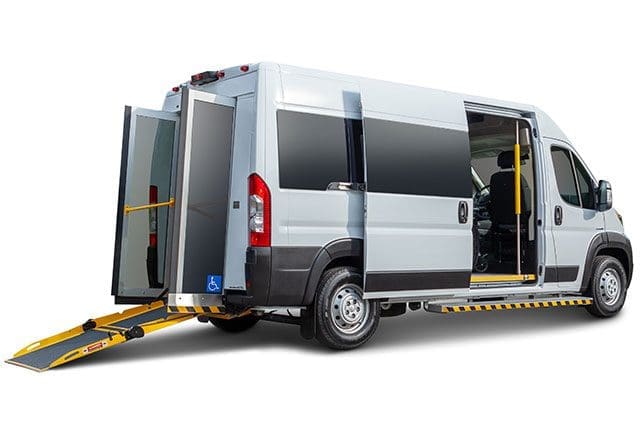
You came to this article to compare a wheelchair van vs. bus, to help you decide which option is right for your organization.
Now, you’ve learned how they compare in terms of accessibility and rider experience, capacity, licensing, ease of use, maintenance and price.
If you’re still not sure which option is right for you–or, if you’ve decided you’d like to move forward with a full size van–parlez à un expert MoveMobility dès aujourd'hui.
Or, continue reading and check out these related articles:



